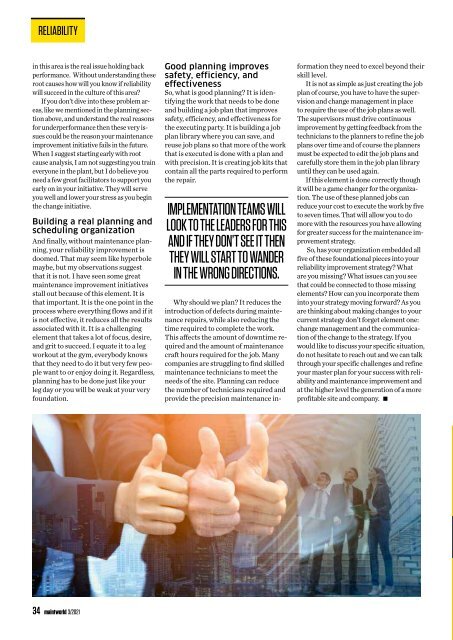Maintworld Magazine 3/2021
- maintenance & asset management
- maintenance & asset management
Create successful ePaper yourself
Turn your PDF publications into a flip-book with our unique Google optimized e-Paper software.
RELIABILITY<br />
in this area is the real issue holding back<br />
performance. Without understanding these<br />
root causes how will you know if reliability<br />
will succeed in the culture of this area?<br />
If you don’t dive into these problem areas,<br />
like we mentioned in the planning section<br />
above, and understand the real reasons<br />
for underperformance then these very issues<br />
could be the reason your maintenance<br />
improvement initiative fails in the future.<br />
When I suggest starting early with root<br />
cause analysis, I am not suggesting you train<br />
everyone in the plant, but I do believe you<br />
need a few great facilitators to support you<br />
early on in your initiative. They will serve<br />
you well and lower your stress as you begin<br />
the change initiative.<br />
Building a real planning and<br />
scheduling organization<br />
And finally, without maintenance planning,<br />
your reliability improvement is<br />
doomed. That may seem like hyperbole<br />
maybe, but my observations suggest<br />
that it is not. I have seen some great<br />
maintenance improvement initiatives<br />
stall out because of this element. It is<br />
that important. It is the one point in the<br />
process where everything flows and if it<br />
is not effective, it reduces all the results<br />
associated with it. It is a challenging<br />
element that takes a lot of focus, desire,<br />
and grit to succeed. I equate it to a leg<br />
workout at the gym, everybody knows<br />
that they need to do it but very few people<br />
want to or enjoy doing it. Regardless,<br />
planning has to be done just like your<br />
leg day or you will be weak at your very<br />
foundation.<br />
Good planning improves<br />
safety, efficiency, and<br />
effectiveness<br />
So, what is good planning? It is identifying<br />
the work that needs to be done<br />
and building a job plan that improves<br />
safety, efficiency, and effectiveness for<br />
the executing party. It is building a job<br />
plan library where you can save, and<br />
reuse job plans so that more of the work<br />
that is executed is done with a plan and<br />
with precision. It is creating job kits that<br />
contain all the parts required to perform<br />
the repair.<br />
IMPLEMENTATION TEAMS WILL<br />
LOOK TO THE LEADERS FOR THIS<br />
AND IF THEY DON’T SEE IT THEN<br />
THEY WILL START TO WANDER<br />
IN THE WRONG DIRECTIONS.<br />
Why should we plan? It reduces the<br />
introduction of defects during maintenance<br />
repairs, while also reducing the<br />
time required to complete the work.<br />
This affects the amount of downtime required<br />
and the amount of maintenance<br />
craft hours required for the job. Many<br />
companies are struggling to find skilled<br />
maintenance technicians to meet the<br />
needs of the site. Planning can reduce<br />
the number of technicians required and<br />
provide the precision maintenance information<br />
they need to excel beyond their<br />
skill level.<br />
It is not as simple as just creating the job<br />
plan of course, you have to have the supervision<br />
and change management in place<br />
to require the use of the job plans as well.<br />
The supervisors must drive continuous<br />
improvement by getting feedback from the<br />
technicians to the planners to refine the job<br />
plans over time and of course the planners<br />
must be expected to edit the job plans and<br />
carefully store them in the job plan library<br />
until they can be used again.<br />
If this element is done correctly though<br />
it will be a game changer for the organization.<br />
The use of these planned jobs can<br />
reduce your cost to execute the work by five<br />
to seven times. That will allow you to do<br />
more with the resources you have allowing<br />
for greater success for the maintenance improvement<br />
strategy.<br />
So, has your organization embedded all<br />
five of these foundational pieces into your<br />
reliability improvement strategy? What<br />
are you missing? What issues can you see<br />
that could be connected to those missing<br />
elements? How can you incorporate them<br />
into your strategy moving forward? As you<br />
are thinking about making changes to your<br />
current strategy don’t forget element one:<br />
change management and the communication<br />
of the change to the strategy. If you<br />
would like to discuss your specific situation,<br />
do not hesitate to reach out and we can talk<br />
through your specific challenges and refine<br />
your master plan for your success with reliability<br />
and maintenance improvement and<br />
at the higher level the generation of a more<br />
profitable site and company.<br />
D<br />
34 maintworld 3/<strong>2021</strong>

















